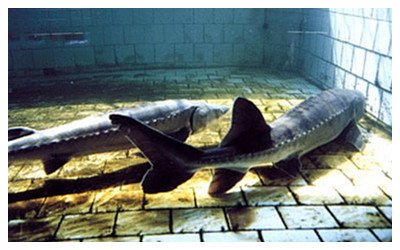
Chinese Sturgeon Museum
 Chinese Sturgeon Museum, located on an islet in the Huangbo River in the Yiling District of Yichang City, is part of the Chinese Sturgeon Research Center which is dedicated to the preservation of rare fishes living in the Yangtze River.
Chinese Sturgeon Museum, located on an islet in the Huangbo River in the Yiling District of Yichang City, is part of the Chinese Sturgeon Research Center which is dedicated to the preservation of rare fishes living in the Yangtze River.
What to see?
From there, visitors can see 10 different species of sturgeon from around the world and all the life-cycle stages of the Chinese Sturgeon.
Chinese sturgeon
The Chinese Sturgeon is one of the oldest species of fish in China, which have existed for about 140 million years (the Caspian Sea, which borders on Russia and Iran, is home to the species of sturgeon that produces that highly-prized commodity, caviar, and it is the oldest sea on earth). The sturgeon has adapted well to its various habitats. And thanks to the efforts by the China’s government, the Chinese sturgeon continues to thrive in well protected habitats.
Known as "The King of Fishes", Chinese sturgeon can reach over 5 meters in length and weigh over 500 kilograms. When the female Chinese sturgeon first becomes sexually mature at the age of 14, she will lay about a million eggs at one time. Unfortunately, only 10% will survive due to the fact that the overabundance of eggs becomes the sustenance to a number of other creatures in the river. Then, only a handful of the hatched surgeon fingerlings will survive the crucial first stages of the 10% eggs. However, start from the very beginning, we have to suppose that a female surgeon could overcome the crucial nature and becomes sexually mature at the age of 14. Life of fish is not easy too.
Protection of Chinese sturgeon
Chinese sturgeon lives mainly in the shallow sea along China's southeastern coastline and spawns in the Yangtze River. From summer to autumn, schools of Chinese sturgeon migrate from the shallow coastal sea areas to the upper reach of Yangtz River, where they match in the river and spawn. Then, the Chinese sturgeon will swim back to the sea with their offspring until it has grown to about 15 centimeters long. However, the construction of Gezhou Dam on the Yangtze has blocked the sturgeon's migration route. So want to minimize the potentially devastating effect of the dam on the fish population, the Chinese government established a research center in 1982, Chinese Sturgeon Research Center, whose primary focus would be the preservation of the Chinese Sturgeon.
Since then, this research center did much work to maintain this species. Since 1984, over 40 thousand juvenile fish (15 centimeters or longer) have been released at the mouth of the Yangtze River, when they returned from the China's southeastern coastline to here when they are sexually mature in order to spawn. Then, they will be captured and "milked" the female’s eggs and the male’s sperm, the eggs are hatched at the research center's hatchery, later when the fingerlings have reached to the required 15 centimeters long, they will be released at the mouth of the Yangtze River.
Travel Tips
Add: No.7, Jijin Road,Xiaoxita,Yiling District,Yichang City 宜昌市夷陵区晓溪塔集锦路7号
Opening Hours: 08:30-17:30
Entrance Fee: CNY 50






 Ask Questions ?
Ask Questions ?